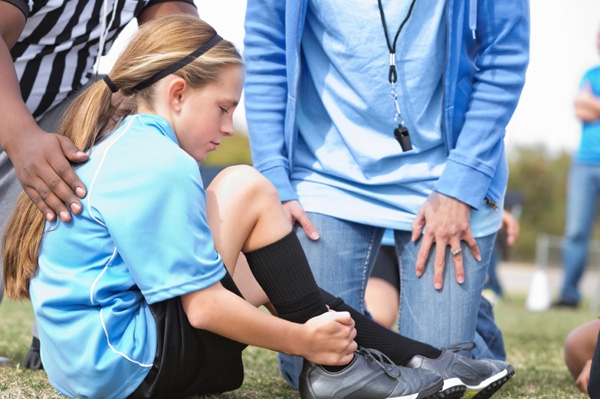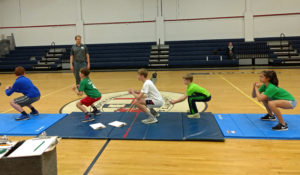Have you ever been injured?
Has your child ever been injured?
Was it serious or not serious?
Did it happen all at once or over time?

The purpose of this blog is to discuss:
- the current observations our youth have about injuries,
- explore three ways injury trends can develop, and
- ask the question: “How can a parent mentor their young athlete to greater durability for their sport?”
Section 1: Observations Young Athletes Have About Injuries
Story #1 Recently I overheard some of my high school students talking to each other about injuries and sports. One student asked: “Are there any sports I can do that I won’t get injured or have less chance of injury?” The friends began naming off sports and how common certain types of injuries occur in specific sports. The group talked about team sports and then individual sports and how demanding or fun each one was. Their discussion finished up talking about Olympic sports like water polo, cross country skiing, and rifle shooting. They also talked about club participation and the cost and benefit of playing competitive sport only and not training for it.
Story #2 Last year I was invited to listen to some student presentations by one of our teachers. The high school students were assigned to do 5 minute presentations for their peers on topics which they researched. There were many different presentations going on at the same time and listeners rotated through to hear each student. One student was talking about how to address injury in our sports culture. He was a current runner on the track team and outlined many professional and college athletes who had been injured including what they did to overcome that seemed to curb the effects of an injury. It was interesting to hear how little anatomy and physiology was included in the presentation. The student did great at sharing the athletes’ mental approach but poorly on understanding how the process of healing and restoration that actually happened. In the end the message was “mind over matter” and “psychology over physiology.”
These two stories paint a picture of the challenge we have in mentoring our young athletes through injuries.
I’ve been injured twice in my life. The first was during overtime in a high school basketball game. I came down on our opponents foot during the jump ball to begin overtime and twisted my ankle hard. Let me give you a little bit of free advice…don’t run on a twisted ankle for an overtime game unless you’d like a pair of crutches to take home! This can be defined as an acute injury because it happened in one event. The second injury happened in my sport of track and field throwing the Javelin. Over the course of a year at the University of Tennessee I suffered two or three tears in my elbow during the season. This can be defined as a chronic injury because it happened over a long period of time. I didn’t know how to properly prepare my arm for throwing and I suffered a UCL (Ulna Collateral Ligament). This eventually led to a “Tommy John” surgery and a lot of life lessons along the way.
Recently I’ve been asking my students: If you’d like to hire a “trainer” or “coach,” you should ask them, “What injuries have you had and how did you overcome them?” This is how you can find out if their knowledge and application creates durability through training.
No one likes to be injured. Have you considered why some young athletes are more injured that others? Are there ways to live and move that build tougher, more durable, youth for participation in sports?
In my explanation I’d like to start with the image of a tree. Are there some trees that are designed to be more tolerant? Yes. Here in Raleigh, NC we live in the “City of Oaks” and the oak tree is a tolerant species. We also have a very high rainfall with this last year being a record! Recently we had a hurricane blow through our state. The major talk during the arrival of Hurricane Florence centered around how many trees were going to fall and the damage they would cause. The main point about hurricanes is they create a lot of force. In order for a tree to continue to stand what must it have? It must have a strong root system to resist that force.
The interesting fact about Hurricane Florence is that we didn’t see many trees topple over. I think because most people didn’t understand the strength and power of the root system in place from a tolerant tree in a humid environment. In our human bodies this root system is our nervous system and can be strengthened and developed in coordination over time. In the sports physiology world this is called the SAID principle which stands for Specific Adaptation Increased Demand. In this next section I’d like to explore the ways injuries can happen.
Section 2: How can Injuries Happen in our Young Athletes?
Any athlete can get injured and no trainer can prevent injuries. With this being said, what are the ways most youth get injured during sports? Notice I said during sports, and not during training. The frequency of young athletes getting injured during practice should be very low.
There are a variety of ways injuries can happen in our young athletes today. I’m going to isolate the few top ways through research and experience. The 3 primary articles I pulled information from are listed at the end of this blog.
#1 Unhealthy knowledge of how to prepare youth for the demands of sports. Our children are not mini-adults. They are underdeveloped from a maturity standpoint. DiFiori, et. all (1) provided a systematic and evidence-based review to assist clinicians to recognize the risks that are unique to the skeletal immaturity young athletes. Growth and development changes over a lifetime and readiness for sports is related to the match between the child’s level of growth and development (motor, sensory, cognitive, social/emotional) and the tasks/demands of the competitive sport. In a previous blog I discussed the ABC’s of long-term development here: The ABC’s of Adolescent Movement Skills Development. For example, chronological age is not always a good indicator for skill development progressions. This unhealthy approach can lead to youth not prepared for sports. Children need a certified professional guiding their movement development.
#2 Physically unprepared youth for the demands of the sport they play. In my experience the approach to youth preparation is either “hot” or “cold” in that they over-do or under-do preparation. Faigenbaum et. all (2) outlines the current status of exercise deficit disorder in youth by saying, “most youth fail to meet current recommendations for daily physical activity, specifically, in the growing years, which can lead to a progression of pathological processes.” This means understanding how problematic this can be for young athletes whose peers influence inactivity. Helping youth develop positive health habits at home can be the greatest way do this better. In short, this is the 4th leading cause of death in the world by the World Health Organization. The practitioner should seek to strike the balance needed for preparation according to pedagogy of the young athletes. In our bodies this is a basic concept called homeostasis we learned in biology class. Kids still need just enough stress in their environment but not do much.
#3 Implementation of good program design including recovery. The first goal of implementing a program is to assess the correct technique using fundamental movement patterns like crawling, hinging, squatting, pushing, and pulling. The second focus which is unique to our systems is to focus on youth identity through life skill lessons. The balance of the approach is the most important aspects for application. Talpey, et all. (3) in exploring the role of the strength and conditioning coach explains the importance in safety and coaching well. The TRIPP (Translating Research into Injury Prevention Practice) model suggests surveys of injuries, reporting injuries, and evaluating the process. The takeaway from this is structure determines function or youth centered focus determines program design. The role of the strength coach is to demonstrate the correct block of training and hold youth coaches accountable for better progressions of volume and load. We use the RPE (Rate of Perceived Exertion) system in our daily communication with athletes and coaches which helps in understanding..
Section #3: How Can We Mentor Young Athletes to Greater Durability for Their Sport?
Using the illustrations from above regarding the tree we can see the importantace of how a tree develops over time. When a tree is cut down and the tree rings are observed it can be seen how the tree grew from year-to-year. With the right environment including soil moisture and nutrients it can experience the best growth. If there was inadequate rain during the year and the environment was especially harsh we would observe little or no growth. In the same way, the development of our young athletes through the way their neuro-muscular system is designed. With the correct progressions of exercises by youth coaches we can create the right environment that promotes skill development from year-to-year in our youth. The classic progressing by Balyi is: Learn to Train, Train to Train, Train to Compete, and Train to Win. Trying to progress these out of order promotes burnout and overuse injuries.
This approach to mentoring our youth will keep the process and the results in focus. There are a few current systems and processes being used effectively that we will promote in this series and with our Summer Life + Movement Skill Camps. The main concept is called Long- Term Athletic Development (LTAD) or Long-Term Development. This is a movement picking up momentum through the practical implementing the ADM (American Developmental Model) into many different sports like: ice hocky, lacrosse, soccer, and football.
Savvy coaches, parents, and those in youth sports should engage the process of mentoring our youth today. If you’d like to learn more this year I want to encourage you to follow this series. Our team of bloggers want to bring truth out the relevant topics and practical applications for a better perspective for tomorrow’s youth!
Research Referenced:
- DiFiori, John P. MD, et all. ACSM Position Statement: Overuse Injuries and Burnout in Youth Sports: A Position Statement from the American Medical Society for Sports Medicine. Clinical Journal of Sports Medicine, Volume 24, Number 1 January 2014
- Faigenbaum, Avery D. MdD, CSCS, et all. The Role of the Pediatric Exercise Specialist in Treating Exercise Deficit Disorder in Youth. Volume 35, Number 3, June 2013
- Talpey, Scott W. PhD et all. Sports Injury Prevention: The Role of the Strength and Conditioning Coach. National Strength and Conditioning Association Strength and Conditioning Journal. Volume 0, Number 0, Month 2017
- Anderson, Tim. Original Strength Blog: Dealing with Injuries https://originalstrength.net/2019/01/21/dealing-with-injury/ January 21st, 2019

Chris Morland, MS, RSCC *D, Original STRENGTH Level 1
MorlandSTRENGTH
Mentor and Coach | Visionary in High School Strength and Conditioning
Director of Strength and Conditioning at Cardinal Gibbons High School | Teacher
Click to follow MorlandSTRENGTH’s Instagram account
“The views, opinions, and judgments expressed in this message are solely those of the authors and peer reviewers. The contents have been reviewed by a team of contributors but not approved by any other outside entity including the Roman Catholic Diocese of Raleigh.”
